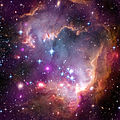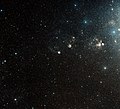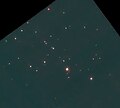NGC 602
| Apparent magnitude (V) | 15.44 (pg)[3] |
|---|---|
| Apparent dimensions (V) | 2.7'[4] |
| Physical characteristics | |
| Mass | - M☉ |
| Radius | 90 ly |
| Estimated age | 5 My[5] |
| - | |
| Other designations | N90[2] |
| Associations | |
| Constellation | Hydrus |
NGC 602 is a young, bright open cluster of stars located in the Small Magellanic Cloud (SMC), a satellite galaxy to the Milky Way. It is embedded in a nebula known as N90.
Radiation and shock waves from the stars of NGC 602 have pushed away much of the lighter surrounding gas and dust that is N90, and this in turn has triggered new star formation in the ridges (or "elephant trunks") of the nebula. These even younger, pre-main sequence stars are still enshrouded in dust but are visible to the Spitzer Space Telescope at infrared wavelengths.[6] The cluster is of particular interest because it is located in the wing of the SMC leading to the Magellanic Bridge. Hence, while its chemical properties should be similar to those of the rest of the galaxy, it is relatively isolated and so easier to study.[7]
NGC 602 contains three main condensations of stars. The central core is NGC 602a, with the compact NGC 602b 100 arc-seconds to the NNW. NGC 602c is a looser grouping 11 arc-minutes to the NE, which includes the
NGC 602 includes many young O and B stars and young stellar objects, with few evolved stars.[9] Ionisation in the nebula is dominated by Sk 183, an extremely hot O3 main sequence star visible as the bright isolated star at the centre of the Hubble image.[10]
A number of other, more distant galaxies also appear in the background of the Hubble images of NGC 602, making for a "tantalizing"[11] and "grand"[12] view.
-
Composite x-ray/optical/infrared image
-
NGC 602 region of the SMC
-
NGC 602c closeup
References
- ^ a b "NGC 602". SIMBAD. Centre de données astronomiques de Strasbourg. Retrieved 2013-04-04.
- ^ a b c "Hubble Observes Infant Stars in Nearby Galaxy". HubbleSite. Retrieved 2007-01-10.
- doi:10.1086/108396.
- .
- ^ Nemiroff, R.; Bonnell, J., eds. (10 January 2007). "NGC 602 and Beyond". Astronomy Picture of the Day. NASA. Retrieved 2007-01-10.
- ^ "NGC 602: Ongoing Star Formation in a Young SMC Cluster". Hubble Heritage Project. January 2007. Retrieved 2007-02-09.
- Bibcode:2005AAS...20718503C.
- .
- S2CID 119206857.
- S2CID 119208446.
- ^ APOD: 2007 January 10 - NGC 602 and Beyond
- ^ "New Stars Shed Light On The Past". Science Daily. 2007-01-09. Retrieved 2007-02-09.
External links
 Media related to NGC 602 at Wikimedia Commons
Media related to NGC 602 at Wikimedia Commons- NGC 602: Taken Under the "Wing" of the Small Magellanic Cloud
- Jan 8, 2007 NASA/ESA HST news and photo release on N90 (at the heart of which lies NGC 602)
- NASA/ESA video 'Zooming on NGC 602' (Hubble Space Telescope)
- NGC 602 @ SEDS NGC objects pages\
- "Progressive star formation in the young SMC cluster NGC 602" Carlson, L. R., et al., 2007 ApJL 665, 109
- "The Initial Mass Function of the Stellar Association NGC 602 in the Small Magellanic Cloud with Hubble Space Telescope ACS Observations" Schmalzl, M., et al. 2008 ApJ 681, 290
- "NGC 602 Environment, Kinematics and Origins" Nigra, L., et al., 2008 PASP 120, 972



